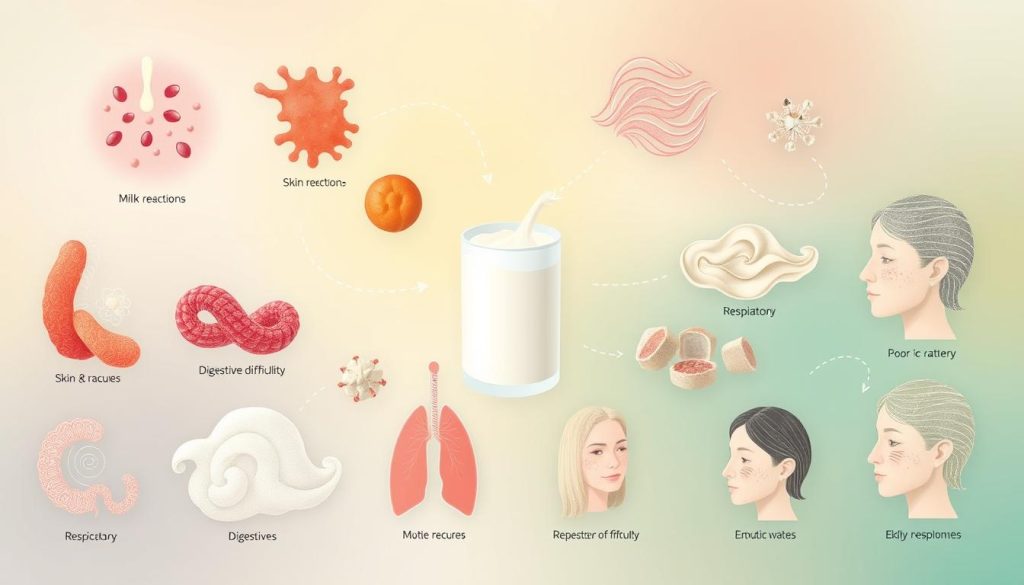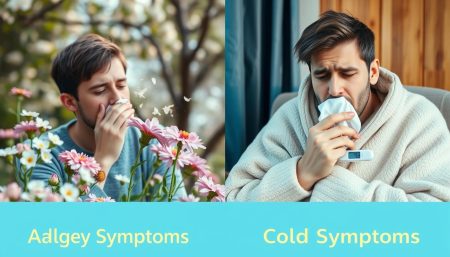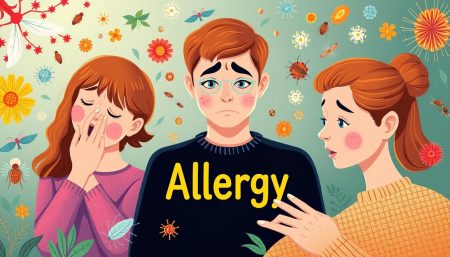As the sun rises on a new year, health is a top concern for millions. Dealing with a milk allergy can be tough. This guide covers the basics of milk allergies, from the first signs of dairy allergy to milk allergy in babies and intolerance to milk symptoms. Let’s dive into the world of milk allergies together, with empathy and depth.
It’s important to understand the differences between milk allergies and dairy intolerance. Both are linked to dairy but affect our bodies differently. For babies, spotting early signs is crucial. This guide aims to shed light on these conditions, helping you feel informed and supported.
Key Takeaways
- Spotting early signs of a dairy allergy is key to managing it well.
- Milk allergy in babies needs careful watching and often special care.
- Telling milk allergy apart from lactose intolerance is vital for the right diagnosis.
- Knowing about intolerance to milk symptoms helps in making better food choices and can boost your quality of life.
- This guide is here to be a caring companion as you learn to live with a milk allergy.
Understanding Milk Allergy and Its Prevalence
Milk allergy is a big deal in the world of food allergies. It affects many people around the globe. Knowing the signs, like cow’s milk allergy symptoms, is key to managing it. This part will cover the basics of milk allergies, how they differ from lactose intolerance, and their common occurrence.
What Is a Milk Allergy?
A milk allergy happens when the body reacts badly to proteins in cow’s milk. It’s different from other dairy issues. Symptoms can range from mild to very serious, like anaphylaxis.
The Distinction Between Milk Allergy and Lactose Intolerance
Milk allergies and lactose intolerance are not the same. Milk allergies are an immune reaction to milk proteins. Symptoms include various signs of milk protein allergy. Lactose intolerance, on the other hand, is when the body can’t digest lactose, a milk sugar.
Epidemiology: Who Gets Milk Allergies?
Milk allergies can happen to anyone, but they’re most common in young kids and babies. Many children grow out of it, but some don’t. Adults can also get milk allergies, making it important to watch for symptoms early.
| Age Group | Prevalence | Common Symptoms |
|---|---|---|
| Infants and Toddlers | Approximately 2-3% | Rashes, hives, respiratory issues |
| Children (5-10 years) | Declining to about 1% | Digestive problems, skin reactions |
| Adults | Rarer, exact figures vary | Anaphylaxis, eczema, and sinus issues |
Recognizing the Early Signs of Dairy Allergy
For many, the journey to manage dairy allergies starts with recognizing dairy allergies early. Spotting milk allergy symptoms early is key. It helps people make diet changes before things get worse. Symptoms can be simple but easy to miss, making awareness and watchfulness crucial for early detection.
Knowing the early signs of a dairy allergy is vital. Here’s a quick guide to some of these signs:
- Swelling or itching around the mouth right after eating dairy.
- Frequent hives or eczema flares after eating dairy.
- Abdominal pain, diarrhea, or vomiting after eating milk products.
- Respiratory issues like wheezing or nasal congestion after dairy.
A table below shows the difference between normal and allergic reactions to dairy.
| Sign/Symptom | Normal Response | Allergic Reaction |
|---|---|---|
| Mouth itching | None | Immediate itching around the mouth |
| Skin Reaction | Possible minor irritation in sensitive individuals | Hives, eczema |
| Stomach Discomfort | Occasional discomfort from overeating | Frequent, severe pain or gastrointestinal upset |
| Respiratory Symptoms | Rarely associated with food intake | Common, especially post dairy consumption |
By spotting these signs early, you can take steps to manage dairy allergies. Remember, early detection of milk allergy leads to better management and a better life for those affected.
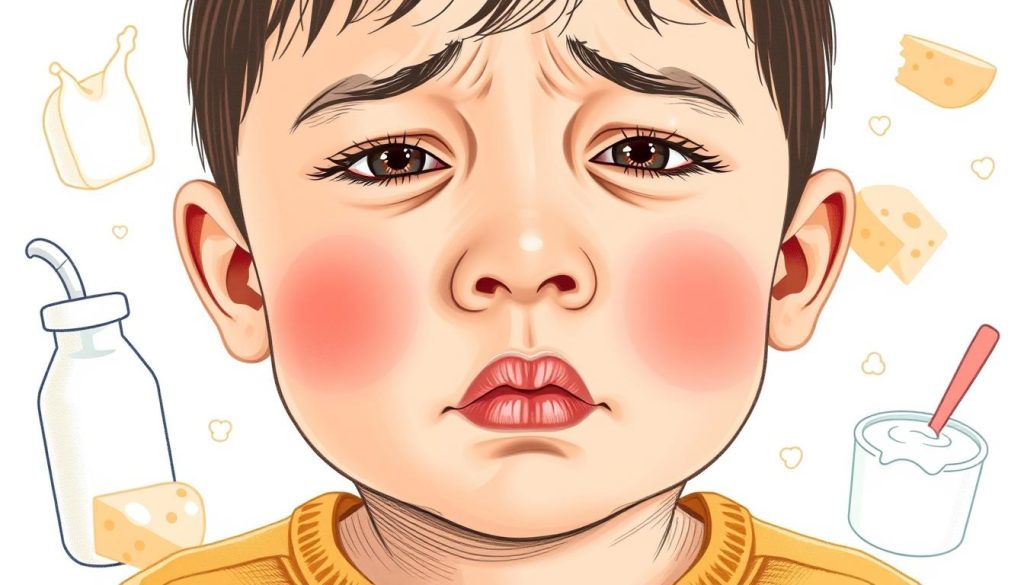
Immune System Response: How the Body Reacts to Milk
People with a dairy allergy have a complex reaction to milk proteins. This reaction shows up in different ways, like digestive issues and immune reactions. The immune system sees milk proteins as threats, causing various reactions.
The Science Behind Milk Protein Allergy Signs
The immune system mistakenly sees milk proteins as threats. It makes antibodies to fight them. This fight releases chemicals like histamine, causing allergy symptoms. Knowing this helps doctors diagnose and treat milk allergies.
Immediate vs. Delayed Reactions in Dairy Allergy
Immediate reactions happen fast, within minutes to hours after eating milk. Symptoms include hives, wheezing, or anaphylaxis. Delayed reactions take longer, sometimes days, and can make diagnosis harder.
| Type of Reaction | Time Frame | Common Symptoms |
|---|---|---|
| Immediate | Minutes to a few hours | Swelling, hives, anaphylaxis |
| Delayed | Several hours to days | Stomach pain, eczema, gastrointestinal upset |
Common Milk Allergy Symptoms in Children and Adults
Milk allergies show different symptoms in kids and adults. This section looks at these differences and how symptoms change over time.
Milk Allergy in Babies: Symptoms to Watch For
Babies with milk allergies might have skin issues like hives. They could also have stomach problems like vomiting or diarrhea. Respiratory issues, like wheezing or coughing, are another sign of a milk allergy in babies.
Transition: How Milk Allergy Symptoms Change with Age
As kids get older, their milk allergy symptoms in children might get better, change, or go away. Adults might face different or worse symptoms, like anaphylaxis or stomach pain. This shows how milk allergy symptoms in adults can last longer. Here’s a closer look at how changes in milk allergy signs over time can show up.
| Age Group | Common Symptoms | Severe Symptoms |
|---|---|---|
| Infants | Colic, rash, wheezing | Severe vomiting, dehydration |
| Children | Hives, gastrointestinal distress | Difficulty breathing, drop in blood pressure |
| Adults | Abdominal pain, dizziness | Anaphylaxis, severe asthma |
The Wide Range of Dairy Allergy Reactions
It’s important to know the varied dairy intolerance symptoms if you’re affected. Reactions can differ a lot from person to person. The spectrum of milk allergy symptoms can range from mild stomach issues to severe, life-threatening reactions.
Dairy products can cause different immune responses in some people. Knowing these reactions helps with accurate diagnosis and managing the condition.
- Mild to moderate symptoms: This may include hives, redness of the skin, gastrointestinal issues such as diarrhea and vomiting, and respiratory problems like wheezing and coughing.
- Severe reactions: Known as anaphylaxis, this acute response is a medical emergency that requires immediate treatment. Symptoms include difficulty breathing, a sharp drop in blood pressure, and dizziness or fainting.
It’s crucial for individuals and caregivers to know these symptoms. This way, they can act quickly when they see them. Early action can lessen the severity of the reactions.
The table below shows common symptoms of dairy allergies and how they can vary by age:
| Age Group | Common Symptoms | Severe Cases |
|---|---|---|
| Infants | Gastrointestinal discomfort, colic, eczema | Wheezing, anaphylaxis |
| Children | Rash, diarrhea, abdominal pain | Difficulty breathing, anaphylaxis |
| Adults | Hives, nasal congestion, digestive issues | Anaphylactic shock, respiratory distress |
Knowing and responding to dairy allergy reactions is key to managing health. It improves the quality of life for those with dairy intolerance. It’s vital to be aware and educated about the spectrum of milk allergy symptoms to support those affected.
Identifying a Milk Allergy Rash: Visual Clues and Symptoms
Spotting a milk allergy rash early is key to managing it. Look out for redness, hives, or eczema-like signs. These clues can help figure out if it’s a milk allergy rash.
Differentiating Between Milk Allergy Rash and Other Skin Conditions
A milk allergy rash shows up fast after eating dairy. It’s different from other skin issues that can come from many things. Watching when and how the rash appears can help find its cause.
Treatment Options for Skin Reactions Due to Milk Allergy
Dealing with skin issues from milk allergy means managing symptoms and avoiding dairy. Antihistamines can help right away. Long-term, you might need to change your diet and see an allergy expert. Here are ways to handle a milk allergy rash:
- Stop eating dairy right away
- Use creams on the rash to make it less severe
- Keep a diary to track what causes the rash
| Treatment | Description | Effectiveness |
|---|---|---|
| Antihistamines | Medication to quickly reduce symptoms like itching and swelling | High |
| Topical Steroids | Creams to lessen inflammation and treat rash | Moderate to High |
| Dietary Adjustment | Complete elimination of dairy products from the diet | High |
For more help, talk to doctors who know about allergies. They can make a plan just for you. This will help with skin reactions to dairy and make life better.

Gastrointestinal Concerns: Milk Allergy Digestive Issues
Milk allergies can cause a lot of discomfort and health problems. They don’t just show up through skin or breathing issues. They also affect the gastrointestinal symptoms of milk allergy. Knowing about these digestive problems helps in managing them better.
Understanding the Link Between Milk and Digestive Symptoms
Drinking milk and eating milk products can lead to milk allergy-induced digestive problems. This happens because the body thinks milk proteins are bad. It then fights them, causing inflammation and irritation in the gut.
Common Gastrointestinal Reactions to Milk Consumption
The way milk affects the digestive system can differ from person to person. But, gastrointestinal symptoms of milk allergy often include stomach pain, bloating, and diarrhea. Here’s a table showing common digestive issues caused by milk allergies.
| Symptom | Description | Frequency |
|---|---|---|
| Abdominal Pain | Cramping and sharp pains in the belly region. | Common |
| Bloating | Feeling of fullness or swelling in the abdominal area. | Often |
| Diarrhea | Frequent loose, watery stools. | Frequently observed |
| Nausea | A feeling of wanting to vomit. | Sometimes |
| Vomiting | Expulsion of the contents of the stomach through the mouth. | Occasional |
This table shows how wide-ranging lactose intolerance symptoms can be. It’s important to tell the difference between lactose intolerance and a true milk allergy. This helps in getting the right treatment and making the right diet changes.
Respiratory and Sinus Problems Related to Milk Allergy
Milk allergies often cause digestive and skin issues. But, many don’t know about the link to respiratory symptoms. People with milk allergies might face milk allergy respiratory symptoms that can be quite severe.
Sinus issues from dairy allergy are a common but overlooked problem. Dairy can cause sinus congestion and pain. This might be mistaken for regular sinus infections or seasonal allergies.
Recognizing the signs of allergic rhinitis from milk, including continuous sneezing, nasal congestion, and an itchy nose, is crucial for proper management and treatment.
This allergy may also cause additional symptoms such as:
- Chronic cough
- Wheezing
- Shortness of breath
These milk allergy respiratory symptoms can be similar to asthma. In some cases, it can make asthma worse.
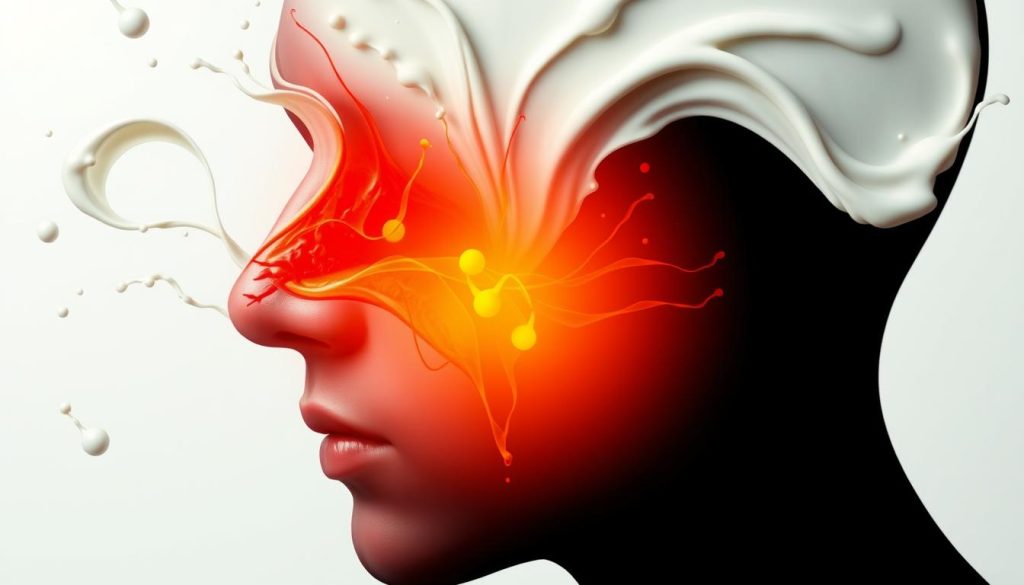
It’s important to understand and manage these symptoms. Avoiding dairy and getting advice from healthcare professionals is key. They can suggest treatments like antihistamines or prescription meds to help with sinus issues from dairy allergy.
Learning about allergic rhinitis from milk and other respiratory symptoms linked to milk allergies is empowering. It helps people make better health and dietary choices, improving their overall wellbeing.
Cow’s Milk Allergy Symptoms vs. Other Dairy Allergies
It’s key to know the difference between cow’s milk allergy symptoms and other dairy allergies. The main immune reactions are similar, but the allergens are different. This makes it important to understand the specific differences.
The Specificity of Cow’s Milk Allergy
Cow’s milk allergy happens when the immune system reacts to proteins in cow’s milk, like casein and whey. Symptoms include skin rashes, stomach problems, and breathing issues. These cow’s milk allergy symptoms can be very severe and happen quickly after eating.
Comparing Symptoms Across Different Types of Dairy
Dairy allergy differentiation is crucial for figuring out which dairy product causes the allergy. Let’s look at the symptoms of various dairy allergies compared to cow’s milk:
| Dairy Product | Common Allergic Symptoms | Onset of Symptoms |
|---|---|---|
| Cow’s Milk | Rashes, abdominal pain, vomiting, wheezing | Rapid, possibly within minutes |
| Goat’s Milk | Similar to cow’s milk, less severe in some cases | Varies, often rapid |
| Sheep’s Milk | Digestive upset, skin eczema | May be delayed |
This comparison shows the range of symptoms of various dairy allergies. It also stresses the need for accurate dairy allergy differentiation.
Chronic Inflammation and Milk Allergy Symptoms
Chronic inflammation from milk allergy is a serious issue that can lead to long-term health problems if not treated right. Milk proteins can trigger an immune response, causing inflammation. This ongoing inflammation can lead to serious health issues, making it crucial to manage dairy-induced inflammation.
People with a dairy allergy often face a variety of symptoms that can last and change over time if not treated. These symptoms are not just about stomach problems. They are complex and need a detailed plan to manage the long-term effects of dairy allergy.
- Swelling in different parts of the body
- Redness and itchiness on the skin
- Persistent gastrointestinal distress such as cramps and bloating
- Respiratory issues, including wheezing and coughing
To tackle these challenges, it’s important to use strategies that focus on managing dairy-induced inflammation. This includes changing your diet to avoid dairy and using anti-inflammatory medicines when needed. It’s also key to listen to your body and know what’s in your food.
“Proper management of dairy allergy is not just about avoiding dairy products; it involves active engagement with your dietary habits, constant vigilance of symptoms, and adapting your lifestyle in a way that prevents the escalation of symptoms into chronic issues.”
It’s also wise to see healthcare professionals often to keep track of your condition and adjust your treatment as needed. This proactive approach is vital to avoid the severe long-term effects of dairy allergy, which can greatly affect your quality of life.

By understanding and managing chronic inflammation from milk allergy, people can live healthier and more comfortable lives despite their allergies. It’s important to focus on education, proactive management, and regular healthcare visits to reduce the negative effects of long-standing dairy allergies.
Milk Allergy Symptoms and Their Impact on Quality of Life
Having a milk allergy is more than just physical symptoms. It deeply affects your emotional and social life. People face challenges like the psychological effects of dairy allergies and the social hurdles of avoiding milk. These issues can greatly impact their quality of life.
Managing a milk allergy involves more than just physical health. It also affects mental well-being and daily social interactions. Understanding these impacts is key to providing the right support and solutions.
Psychological Effects of Living with a Milk Allergy
The psychological effects of dairy allergies are significant. People often feel isolated or anxious about accidentally eating milk products. This stress can cause emotional distress.
Constantly being on guard can also take a toll on mental health. It can lead to feelings of fatigue or frustration. It’s important to recognize these effects to offer the right support.
The Social and Dietary Challenges of Milk Allergy
One big challenge is going to social events where food is served. People have to ask about ingredients, which can be stressful and awkward. This can make them feel left out or like a burden.
It also affects their social relationships and makes them less likely to join in. Planning meals ahead of time is necessary, which can make social interactions less spontaneous.
Table: Comparison of Psychological and Social Challenges in Milk Allergy Management
| Aspect | Impact | Management Strategies |
|---|---|---|
| Psychological | Anxiety, isolation, and stress due to potential exposure | Support groups, mental health counseling, personal education |
| Social | Social awkwardness, potential exclusion at social events | Detailed dietary planning, communication techniques with hosts |
Diagnosing Milk Allergy: Tests and Procedures
It’s important to diagnose milk allergies well to manage symptoms and stay healthy. Doctors mainly use two methods: milk protein allergy testing and elimination diets.

Professional Allergy Testing for Milk Proteins
Milk protein allergy testing helps doctors see if a patient’s immune system reacts too much to milk proteins. They use skin prick tests and blood tests to check how the immune system reacts to milk proteins.
Elimination Diets and Their Role in Diagnosis
Elimination diet for dairy allergy is key in finding out if someone has a milk allergy. It means not eating any dairy for 2-4 weeks and watching for symptom changes. If symptoms get better, dairy is slowly added back to see if symptoms come back, proving a milk allergy.
- Initial elimination of all dairy items
- Close monitoring of health changes and symptom improvements
- Systematic reintroduction of dairy to assess reaction
Strategies for Managing and Living With a Milk Allergy
Living with a milk allergy means being careful to avoid allergens. It’s important to keep a healthy diet. By using the right strategies, people can lessen their symptoms and live better lives.
Dietary Substitutes and Lactose-Free Options
Finding good dairy substitutes is key for those with milk allergies. Today, there are many lactose-free diets available. Options like almond, soy, and oat milks are great. Brands like Almond Breeze and Silk offer choices that taste good and are nutritious.
- Almond milk – rich in vitamin E, low in calories
- Soy milk – high in protein, fortified with vitamins D and calcium
- Oat milk – good source of fiber, naturally sweet
These alternatives help manage milk allergies and are good for your health.
Understanding Food Labels and Avoiding Hidden Dairy
Reading food labels for milk content is very important for those with milk allergies. Dairy can be hidden in foods like sausages, biscuits, and even canned tuna.
To stay safe, look for “contains milk” or specific dairy ingredients like whey, casein, and lactose. Also, be careful of terms like “natural flavors” and “artificial flavoring.” They might include dairy.
By choosing lactose-free diets and reading labels carefully, people can avoid dairy. This helps them keep a balanced and nutritious diet.
Conclusion
Becoming well-informed is key when dealing with managing milk allergy symptoms. We’ve looked at the differences between milk allergy and intolerances. We’ve also seen how symptoms can vary by age and how the body reacts to dairy.
By educating on dairy allergies, people can make lifestyle changes to stay healthy. This helps reduce the risk of allergic reactions.
Living with milk allergies can be tough, but it’s not impossible. With the right support for milk allergy sufferers and management strategies, challenges can be overcome. Steps like reading food labels, choosing hypoallergenic formulas for babies, and finding lactose-free options are crucial.
These actions help create a safe space. Offering empathetic and helpful advice is vital, especially when diet and routine changes are needed.
For more information on symptoms, risk factors, and prevention, check out the Mayo Clinic’s guide. Remember, milk allergy is serious, but with the right knowledge, people can live a full and healthy life. Let education guide you, stay vigilant, and find support in your community.
FAQ
Q: What are the common signs of a dairy allergy?
A: Signs of a dairy allergy include hives, swelling, and vomiting. Diarrhea and severe reactions like anaphylaxis can also occur. If you think you have a dairy allergy, see a doctor for a proper diagnosis.
Q: How do milk allergy symptoms present in babies?
A: Babies with milk allergies might have colic, hives, or eczema. They may also vomit, have diarrhea, or not grow well. If you’re worried about your baby’s allergies, get medical help right away.
Q: What does intolerance to milk symptoms entail?
A: Milk intolerance, often lactose intolerance, causes digestive problems. These include gas, bloating, diarrhea, and stomach pain after eating dairy. It happens because the body can’t break down lactose well.
Q: What distinguishes milk allergy from lactose intolerance?
A: Milk allergy is an immune reaction to milk proteins, causing rashes and breathing issues. Lactose intolerance is when the body lacks lactase, leading to digestive symptoms. They are different because of how the body reacts.
Q: Who is most likely to develop milk allergies?
A: Infants and young children often get milk allergies, especially in the first year. Some kids outgrow it, but others may keep it into adulthood. Adults can also get milk allergies, but it’s rarer.
Q: What are typical milk protein allergy signs?
A: Signs of milk protein allergy include skin reactions like hives and respiratory issues. Gastrointestinal problems and anaphylaxis can also happen. Symptoms can appear right away or hours later after eating milk or dairy.
Q: What does an immediate reaction to dairy look like compared to a delayed reaction?
A: Immediate reactions to dairy include hives, swelling, and anaphylaxis within minutes to hours. Delayed reactions might be gastrointestinal issues, eczema, or respiratory problems, appearing hours to days later.
Q: Can milk allergy symptoms in children evolve over time?
A: Yes, milk allergy symptoms in children can change. Some outgrow their allergies, while others may have different reactions or persistent symptoms into adulthood.
Q: How can I recognize a milk allergy rash?
A: A milk allergy rash looks like red, itchy welts or hives on the skin. It can be small or cover a lot of skin and happens quickly after eating dairy.
Q: What are the gastrointestinal symptoms of a milk allergy?
A: Gastrointestinal symptoms include nausea, vomiting, diarrhea, and stomach cramps. Sometimes, constipation can also occur. Symptoms vary in severity and how long they last.
Q: How can a milk allergy affect the respiratory system?
A: Milk allergy can cause respiratory symptoms like wheezing, coughing, and nasal congestion. In severe cases, it can lead to breathing problems or asthma-like symptoms.
Q: What symptoms are unique to cow’s milk allergy?
A: Cow’s milk allergy symptoms are similar to other dairy allergies but are triggered by cow’s milk proteins. They include immediate reactions like hives or anaphylaxis and delayed reactions like eczema or stomach issues.
Q: What are the long-term effects of chronic inflammation from milk allergy?
A: Chronic inflammation from milk allergy can lead to conditions like eczema and recurrent ear infections. It can also cause gastrointestinal disorders. Long-term inflammation may increase the risk of other allergies or autoimmune diseases.
Q: How does living with a milk allergy impact quality of life?
A: Living with a milk allergy means following a strict diet and reading food labels carefully. It can also lead to social isolation during meals. It can be stressful, affecting mental health and overall quality of life.
Q: What tests are used to diagnose a milk allergy?
A: Doctors use skin prick tests, blood tests, oral food challenges, or elimination diets to diagnose milk allergy. Accurate diagnosis is key to managing the allergy effectively.
Q: Are there strategies for managing a milk allergy?
A: Yes, managing a milk allergy involves avoiding dairy, reading labels, and educating others about the allergy. Emergency medication like antihistamines or epinephrine is crucial for accidental exposure.












